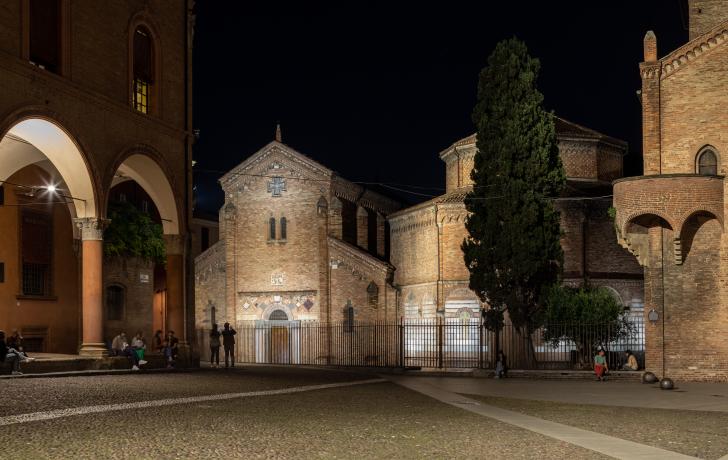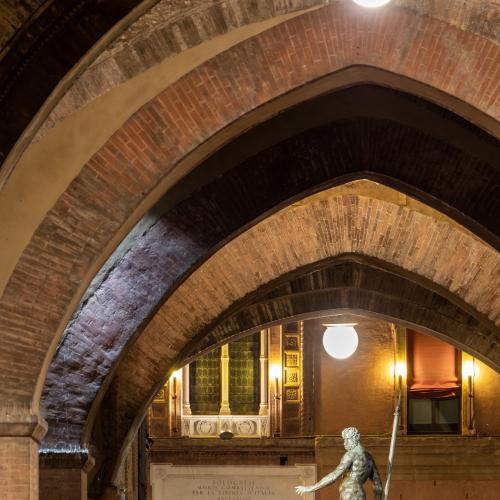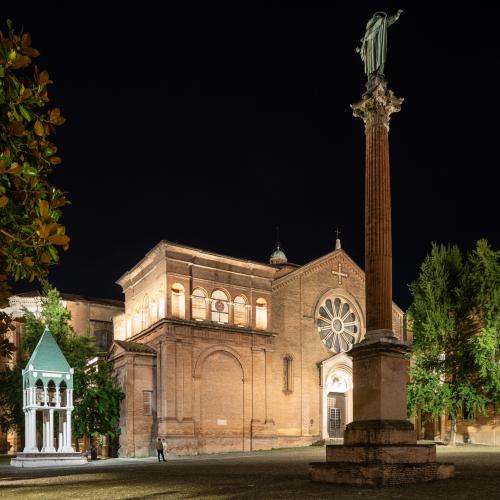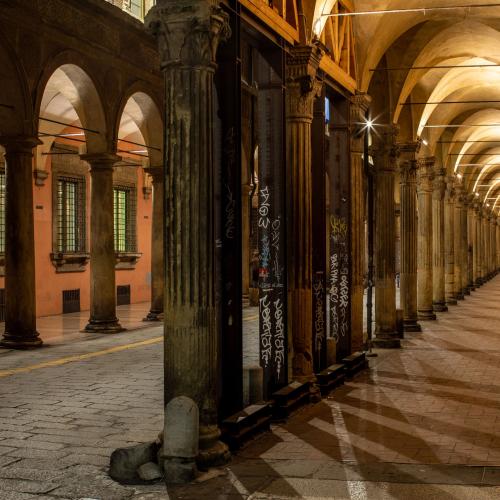Indeed, the Municipality, in agreement with the Superintendence, has uniformed the luminaires under the porticoes, eliminating the varied lighting solutions that have accumulated over time, and also cables and light spots annoying to the sight, as in the case of Piazza Santo Stefano, returned to a metaphysical sharpness.
The work, conducted by the design studio I-DEA Luce Architettura of the architect Lorenza Golinelli and the engineer Alberto Ricci Petitoni, was documented by the photographer OSCAR FERRARI in an exhibition open until 25 June at the Salaborsa library (Scuderie, Piazza Nettuno 3) under the title La luce di Bologna.
We asked the author of the images some questions. Ferrari, specialised in architecture photography, lives and works in Bologna.
In what does this cycle of photographs differ from your usual production?
I have photographed architecture for many years, but this work presents some aspects of novelty and originality with respect to my whole previous professional experience. Particularly the scale and the subject matter of the project.
In which sense?
It is the first commissioned photographic work concerning an urban context, and requests to document an entire urban area, although limited to the historic centre, are very rare if not to say non-existent nowadays; also in the case of urban interventions, it is difficult to have so great an extension as a subject. I remember two examples more emblematic than all the others: the photographers of the Municipality of Paris in charge of documenting - before and after - the great urban transformations conducted by Haussmann in the 1850s to 1870s, and the survey on the historic centre conducted by Paolo Monti under the appointment of the Municipality of Bologna in 1970.
In my case, the request to compile the documentation did not come from the Municipality but from the private designer in charge of carrying out the renovation of the urban lighting of Bologna, the design studio I-dea of Imola, working for many years in this specific sector.
Back to the subject instead?
It is the first work where the purpose of the design is immaterial. I have photographed a large variety of architectures, houses, offices, churches, hospitals, gyms. cemeteries, etc... Here it is not about the architecture but only the way it is illuminated, the light is the true and only protagonist of the project. Initially I had no idea of how to approach so large a work. To photograph a lighting design does not mean to show its luminaires, whether restored or redesigned, this would be a relatively simple industrial documentation work, but on the contrary it must show the light that spreads over the architectures, porticoes and squares without having the precise perception of from where it is coming. The light that highlights or hides according to the sensibility of the designer
How have you worked ‘at night’? And how does your work differ from the photographs taken with natural light?
I don’t want to give technical information from a photography manual, but rather a useful reflection for who works with light, or for who simply takes night photographs as a hobby without ever having thought of what it entails. They may seem obvious and commonplace, but there are differences between natural and artificial light way beyond obvious when seen from the photographer's point of view.
Not light and shadow but light and darkness, perhaps?
Natural light obviously depends on the sun, which in its "rotation" (the photographer considers that the sun "rotates" to get different light-shadows) illuminates each architectural element differently, for example a city gate. The gate, during the various hours of the day, is subject to different light situations as it presents the same side in favour of or against the light and during this time period different shadows are generated. Artificial light does not create this effect but it spreads in a uniform manner over the volume to be illuminated, remaining constant at any time of the night.
Artificial light removes the darkness of the illuminated part, there are no shadow zones but zones that become darker and darker as the light source gets farther away, becoming always darker and less legible. Caravaggio could help us to understand the concept of bodies removed from darkness.
It would seem a completely different work...
The sun offers a unique illumination point, weaker or stronger if the sky is more or less cloudy, but the light source to be kept under control is only one, while in a city at night the light sources are infinite. In addition to those designed and carefully positioned to avoid glare, there are many others that seem specially made to disturb, entering into conflict with the first ones and above all with the photographer, for example: store windows, signs, street lighting, traffic lights, vehicle headlamps, etc...each located more or less randomly and almost impossible to control photographically.
Daylight does not create tricks. Although variable, it is much easier for the photographer to manage because if he or she doesn't position themselves completely against the sun (but who does that?), it would be difficult to find undesirable reflections. Night photography, on the other hand, subjects the photographer to an infinity of adverse elements. The myriad of stars at 8 -10 points, depending on the shutter, which are generated in the presence of punctual light sources, red or white trails produced by the headlamps of moving cars and bicycles, reflections produced by street lights on posts or heads. The latter are more difficult to manage because if the lamp that generates them is inside the image frame, you certainly cannot expect the reflection to move as the sun does, or you either keep the reflections or you don’t photograph at all.
How is space perceived at this point? How do our porticoes behave?
The alternation between natural and artificial light clearly changes the perception of space, and the effects of this variation seem to me mostly avoidable in the particular and characteristic space of the portico.
During the day, lit only from the outside, it collects projected lights and shadows, drawing on the ground the typical rhythmic alternation that extends in perspective. During the night, the opposite takes place, the light coming only from inside, mainly diffused by the vaults, makes you perceive the public space as an intimate and private environment, a hallway in the home, a room or a church nave.
The photos are by Oscar Ferrari, all rights reserved




